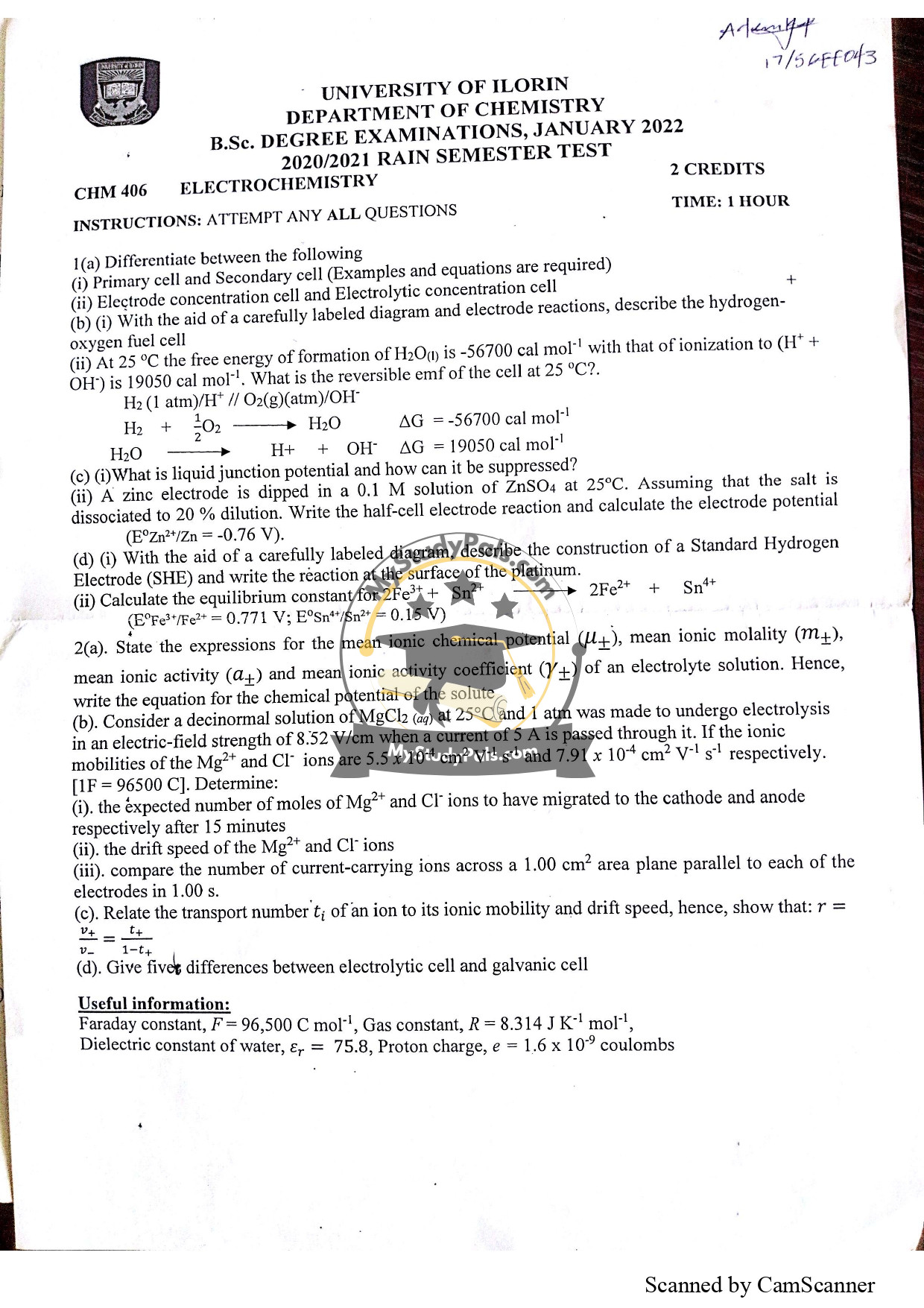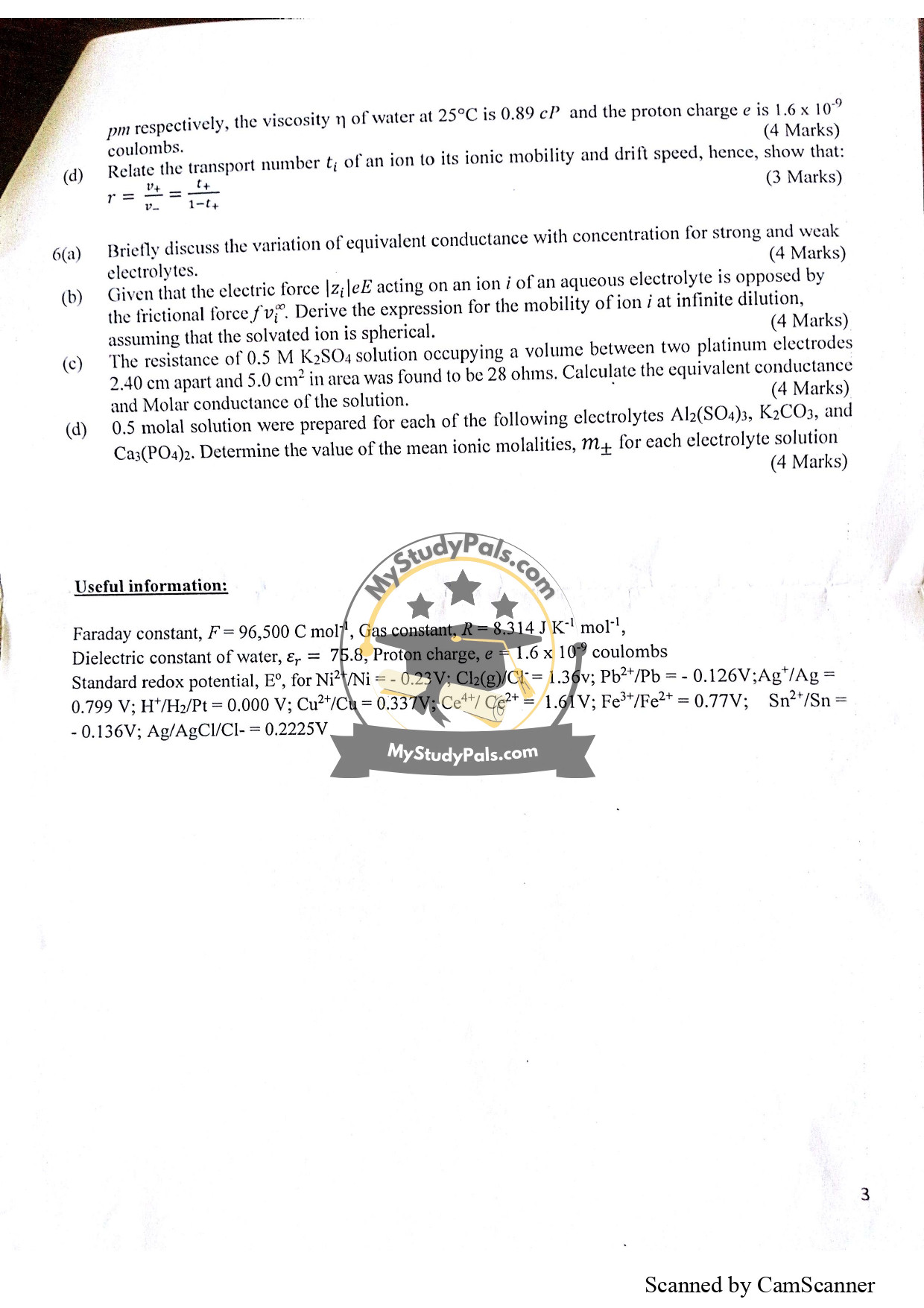ANWSER
Question 1(a)(i): Differentiate between Primary cell and Secondary cell (Examples and equations are required).
Answer:
– Primary Cell: Non-rechargeable, single-use cell where reactions are irreversible. Example: Zinc-carbon battery.
Reactions:
Anode: \( \text{Zn} \rightarrow \text{Zn}^{2+} + 2\text{e}^- \)
Cathode: \( 2\text{MnO}_2 + 2\text{NH}_4^+ + 2\text{e}^- \rightarrow \text{Mn}_2\text{O}_3 + 2\text{NH}_3 + \text{H}_2\text{O} \)
– Secondary Cell: Rechargeable, reversible reactions. Example: Lead-acid battery.
Reactions:
Discharge:
Anode: \( \text{Pb} + \text{SO}_4^{2-} \rightarrow \text{PbSO}_4 + 2\text{e}^- \)
Cathode: \( \text{PbO}_2 + 4\text{H}^+ + \text{SO}_4^{2-} + 2\text{e}^- \rightarrow \text{PbSO}_4 + 2\text{H}_2\text{O} \)
—
Question 1(a)(ii): Differentiate between Electrode concentration cell and Electrolytic concentration cell.
Answer:
– Electrode Concentration Cell: Uses two identical electrodes at different concentrations. Example:
\( \text{Cu}|\text{Cu}^{2+}(c_1)||\text{Cu}^{2+}(c_2)|\text{Cu} \)
Emf arises due to concentration difference of the same ion.
– Electrolytic Concentration Cell: Uses two identical electrolytes at different concentrations separated by a salt bridge. Example:
\( \text{Ag}|\text{AgNO}_3(c_1)||\text{AgNO}_3(c_2)|\text{Ag} \)
Emf due to ion concentration gradient.
—
Question 1(b)(i): Describe the hydrogen-oxygen fuel cell with labeled diagram and reactions.
Answer:
– Diagram:
– Anode (H₂): Platinum electrode in H₂ gas.
– Cathode (O₂): Platinum electrode in O₂ gas.
– Electrolyte: Aqueous KOH.
– Load: External circuit.
– Reactions:
Anode: \( \text{H}_2 + 2\text{OH}^- \rightarrow 2\text{H}_2\text{O} + 2\text{e}^- \)
Cathode: \( \frac{1}{2}\text{O}_2 + \text{H}_2\text{O} + 2\text{e}^- \rightarrow 2\text{OH}^- \)
Overall: \( \text{H}_2 + \frac{1}{2}\text{O}_2 \rightarrow \text{H}_2\text{O} \)
—
Question 1(b)(ii): Calculate the reversible emf of the given cell at 25°C.
Answer:
Given:
– \( \Delta G_1 = -56700 \, \text{cal/mol} \) (formation of \( \text{H}_2\text{O} \))
– \( \Delta G_2 = 19050 \, \text{cal/mol} \) (ionization of \( \text{H}_2\text{O} \))
– Net \( \Delta G = \Delta G_1 + \Delta G_2 = -37650 \, \text{cal/mol} \)
– Convert to J: \( \Delta G = -37650 \times 4.184 = -157,527.6 \, \text{J/mol} \)
– Emf (\( E \)): \( E = -\frac{\Delta G}{nF} = \frac{157,527.6}{2 \times 96500} = 0.816 \, \text{V} \)
—
Question 1(c)(i): What is liquid junction potential and how can it be suppressed?
Answer:
– Definition: Potential difference at the interface of two electrolytes due to ion mobility differences.
– Suppression: Use a salt bridge (e.g., KCl) with ions of similar mobility (\( K^+ \) and \( Cl^- \)).
—
Question 1(c)(ii): Calculate the electrode potential of Zn in 0.1 M ZnSO₄ (20% dissociation).
Answer:
– \( \text{Zn}^{2+} \) concentration: \( 0.1 \times 0.2 = 0.02 \, \text{M} \)
– Nernst equation: \( E = E^\circ + \frac{0.0591}{n} \log[\text{Zn}^{2+}] \)
\( E = -0.76 + \frac{0.0591}{2} \log(0.02) = -0.76 – 0.050 = -0.81 \, \text{V} \)
—
Question 1(d)(i): Describe the Standard Hydrogen Electrode (SHE) and its reaction.
Answer:
– Construction: Platinum electrode coated with Pt black, immersed in 1 M HCl, bathed in H₂ gas at 1 atm.
– Reaction: \( 2\text{H}^+ + 2\text{e}^- \rightleftharpoons \text{H}_2 \)
—
Question 1(d)(ii): Calculate the equilibrium constant for the reaction \( 2\text{Fe}^{3+} + \text{Sn}^{2+} \rightarrow 2\text{Fe}^{2+} + \text{Sn}^{4+} \).
Answer:
– \( E^\circ_{\text{cell}} = E^\circ_{\text{Fe}^{3+}/\text{Fe}^{2+}} – E^\circ_{\text{Sn}^{4+}/\text{Sn}^{2+}} = 0.771 – 0.15 = 0.621 \, \text{V} \)
– \( \Delta G^\circ = -nFE^\circ = -2 \times 96500 \times 0.621 = -119,853 \, \text{J/mol} \)
– \( K = e^{-\Delta G^\circ/RT} = e^{119853/(8.314 \times 298)} \approx 1.66 \times 10^{21} \)
—
Question 2(a): State expressions for mean ionic chemical potential, mobility, activity, and activity coefficient.
Answer:
– \( \mu_{\pm} = \nu_+ \mu_+ + \nu_- \mu_- \)
– \( m_{\pm} = (m_+^{\nu_+} m_-^{\nu_-})^{1/\nu} \)
– \( a_{\pm} = \gamma_{\pm} m_{\pm} \)
– \( \gamma_{\pm} = (\gamma_+^{\nu_+} \gamma_-^{\nu_-})^{1/\nu} \)
– Chemical potential of solute: \( \mu = \mu^\circ + \nu RT \ln a_{\pm} \)
—
Question 2(b)(i): Calculate moles of Mg²⁺ and Cl⁻ migrated after 15 minutes.
Answer:
– Total charge (\( Q \)): \( 5 \, \text{A} \times 900 \, \text{s} = 4500 \, \text{C} \)
– Moles of \( \text{Mg}^{2+} \): \( \frac{4500}{2 \times 96500} = 0.0233 \, \text{mol} \)
– Moles of \( \text{Cl}^- \): \( \frac{4500}{96500} = 0.0466 \, \text{mol} \)
—
Question 2(b)(ii): Calculate drift speeds of Mg²⁺ and Cl⁻.
Answer:
– \( v_{\text{Mg}^{2+}} = u_+ E = 5.5 \times 10^{-4} \times 8.52 = 4.69 \times 10^{-3} \, \text{cm/s} \)
– \( v_{\text{Cl}^-} = u_- E = 7.91 \times 10^{-4} \times 8.52 = 6.74 \times 10^{-3} \, \text{cm/s} \)
—
Question 2(d): Give five differences between electrolytic and galvanic cells.
Answer:
1. Energy Conversion: Galvanic converts chemical to electrical; electrolytic uses electrical for chemical reactions.
2. Anode/Cathode: Anode is negative in galvanic, positive in electrolytic.
3. Spontaneity: Galvanic reactions are spontaneous; electrolytic are non-spontaneous.
4. Salt Bridge: Galvanic uses it to prevent charge buildup; electrolytic may not need it.
5. Examples: Galvanic—battery; electrolytic—electroplating.
—





